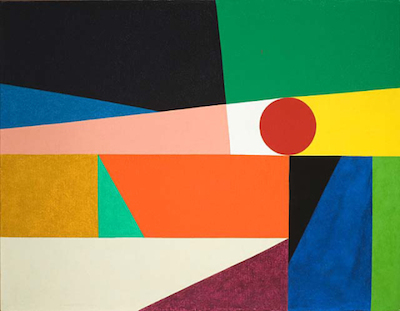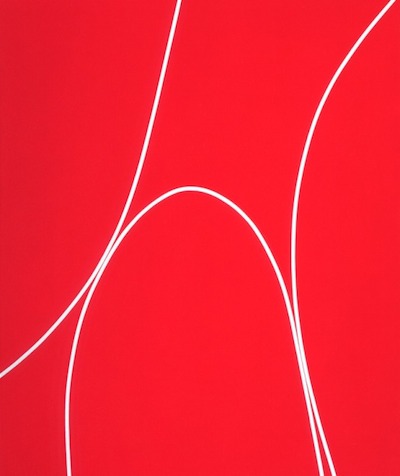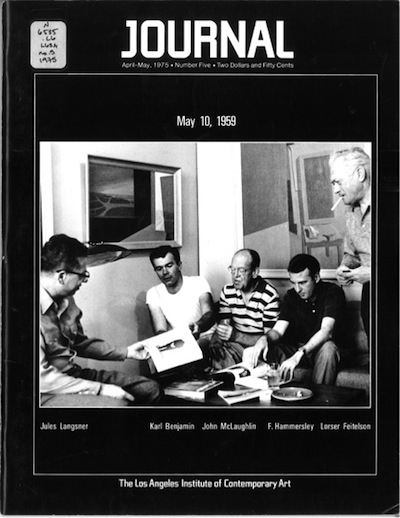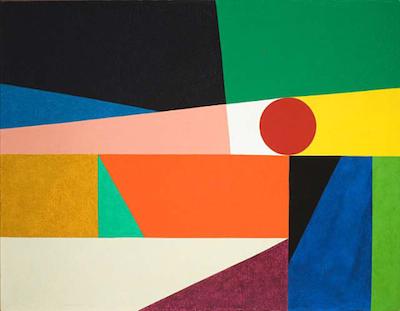One of the interesting trends in recent curatorial practice is to restage or revisit important historical exhibitions. These shows typically take one of two approaches: faithfully reconstructing an exhibition from the past (such as New York gallery Zwirner & Wirth’s 2008 redo of Dan Flavin’s 1964 exhibition at Green Gallery), or conceiving of a new project that uses a past exhibition as a conceptual jumping-off point (for example, When Attitudes Became Form Become Attitudes at San Francisco’s CCA Wattis Institute for Contemporary Arts in 2012, a contemporary riff on the famous Live in Your Head: When Attitudes Become Form at Kunsthalle Bern in 1969).
Four Abstract Classicists, which opened this past Saturday, organized by curator of modern art Carol S. Eliel, falls somewhere between these two tactics. Taking its title from an exhibition of the same name mounted in 1959 at the Los Angeles County Museum in Exposition Park (the institutional predecessor of modern-day LACMA), the show brings together works by the same four Southern California painters who were in the 1959 exhibition: Karl Benjamin, Lorser Feitelson, Frederick Hammersley, and John McLaughlin. Despite the two exhibitions’ shared title and artists, however, the new show is not a reconstruction; in fact, only one painting from the original grouping—Frederick Hammersley’s Around a round (1959)—appears in the upcoming presentation.
 Frederick Hammersley, Around a round, 1959, bequest of Fannie and Alan Leslie, © Frederick Hammersley Foundation
Frederick Hammersley, Around a round, 1959, bequest of Fannie and Alan Leslie, © Frederick Hammersley Foundation
Following the 1959 show, the term “abstract classicism” (a designation meant to signal these painters’ differences from the abstract expressionism of artists such as Jackson Pollock and Franz Kline) continued to be used in reference to Benjamin, Feitelson, Hammersley, and McLaughlin. Interestingly, however, the question of who actually conceived of the 1959 show and its title has been a subject of some contention.
 Lorser Feitelson, Hard Edge Line Painting, 1963, Anonymous gift through the Contemporary Art Council, © The Feitelson/Lundeberg Art Foundation
Lorser Feitelson, Hard Edge Line Painting, 1963, Anonymous gift through the Contemporary Art Council, © The Feitelson/Lundeberg Art Foundation
In 1975, an innocuous essay by Paul Karlstrom (who was then the West Coast–area director of the Archives of American Art) for LAICA Journal, a magazine published by the now-defunct Los Angeles Institute of Contemporary Art, mentioned in passing the archives’ acquisition of papers belonging to Jules Langsner, the Los Angeles critic who served as curator of the original Four Abstract Classicists. In response, art historian Peter Selz wrote a letter to Karlstrom asserting it was he, and not Langsner, who initiated the show and suggested its title. Selz’s letter was published in the following issue of LAICA Journal, along with a response by June Harwood, Langsner’s widow (in which she refuted Selz’s claim), and a reprint of a 1959 letter from Benjamin to art critic Sidney Tillim crediting Langsner with forming the idea for the “abstract classicists” group.
 Cover of the April–May 1975 issue of LAICA Journal
Cover of the April–May 1975 issue of LAICA Journal
Weighing the various claims and counterclaims about who should get credit, art critic Peter Plagens, writing in the same issue of LAICA Journal, offered his assessment—and, it would seem, a final word on the subject:
“Although no one can say for sure who first put the bug in whose ear, especially (and perhaps deliberately) so long after Langsner’s death, it seems “abstract classicism” is nobody’s baby, dating from 1951 or earlier. As to the conception/organization, my understanding is that Karl Benjamin brought Jules Langsner to meet Peter Selz, then teaching at Pomona, and Selz offered the college as a site for the show; Feitelson countered that it ought to be done in a first-class museum in Los Angeles or San Francisco or not at all, the artists agreed, and Selz’s ‘participation’ ended there. As to his conceiving the show, I managed to contact two of the participants, and their answers were, in a word, ‘bullshit!’”
Jennifer King, Wallis Annenberg Curatorial Fellow, Modern Art



